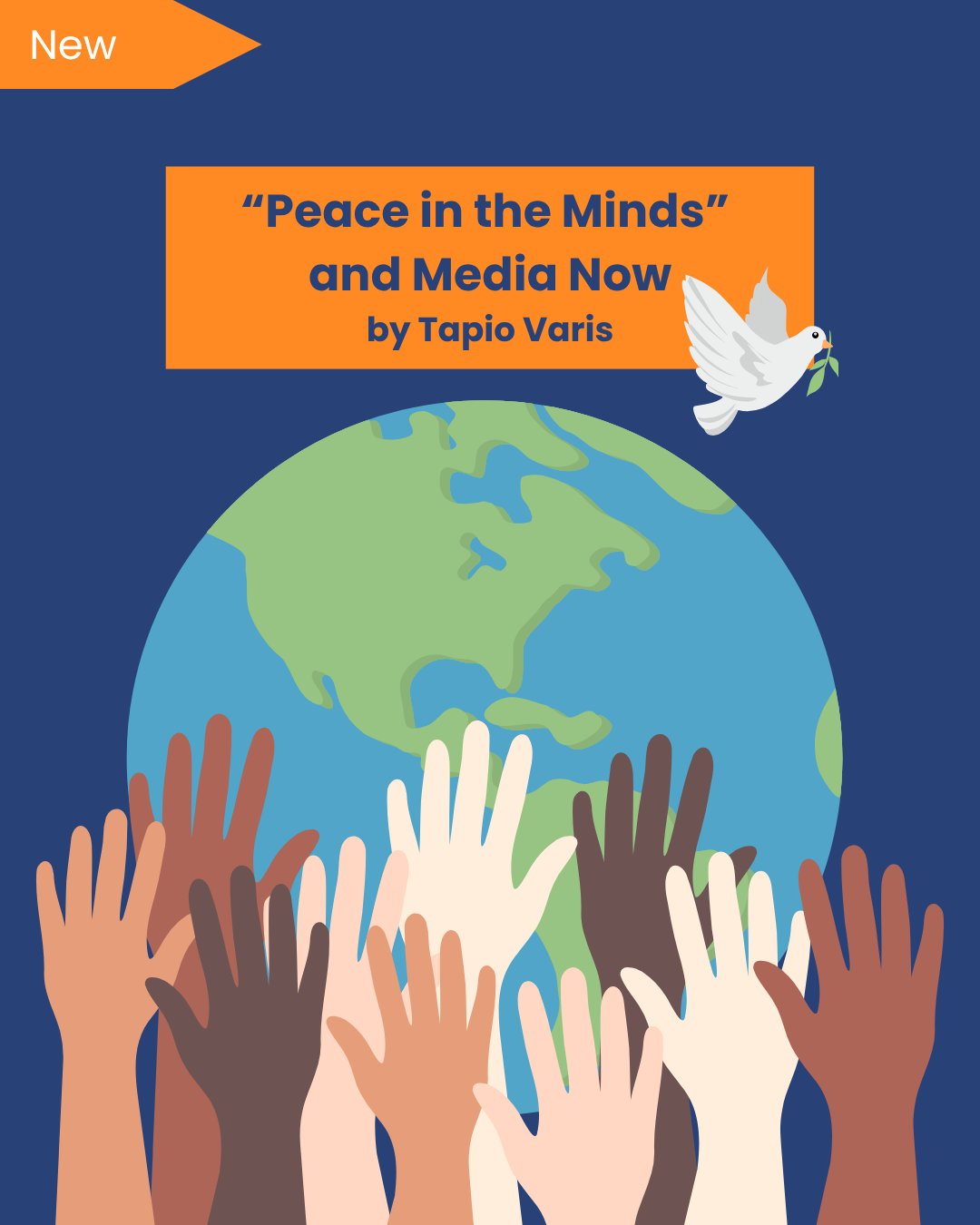
The word “hallucinate” was announced as the word of the year by the Cambridge Dictionary in 2023. It means “to seem to see, hear, feel, or smell something that does not exist, usually because of a health condition or because you have taken a drug”. The term “hallucination” originates from the Latin word “alucinari,” meaning to wander in the mind. Yet, the Cambridge Dictionary added another definition for the word that signifies the emergence of a new phenomenon: “When an artificial intelligence hallucinates, it produces false information”. This indicates that AI may have the capacity to produce seemingly convincing yet entirely false answers. Furthermore, not only does the process by which AI systems generate answers remain unknown but also AI systems are considered to generate unpredictable and biased answers. Therefore, individuals may need to critically analyse and determine the accuracy of the information generated by AI, which indicates the increasing importance of media literacy.
Considering these issues, in an era where AI is increasingly becoming a commonly used tool for information retrieval, its convenience often comes with an expensive price. Recently, the European Commission Vice-President for Values and Transparency Vera Jourova stated that AI tools lead to fresh challenges in the fight against disinformation. Disinformation is defined as “false information spread in order to deceive people”. This is where the importance of media literacy may become prominent when there is a risk of AI systems hallucinating by making up answers that sound convincing.
Accordingly, AI hallucination is defined as “a phenomenon where AI generates a convincing but completely made-up answer”. OpenAI’s notes openly acknowledge the potential for ChatGPT, a prominent AI language model, to generate responses that sound plausible yet are nonsensical or outright incorrect. What’s alarming is that many individuals may encounter this phenomenon without even realizing it. As users, we find ourselves entrusting AI systems with the responsibility of providing accurate and reliable information, exposing ourselves to the risks of accepting misinformation unintentionally. If we want to make sure that the information we access is accurate and credible, it is important to recognize the existence of AI hallucination and approach AI-generated content with a healthy dose of scepticism and a commitment to critical thinking.
Moreover, the process by which AI formulates responses remains largely opaque, with the end product being received and consumed. However, the important part lies precisely in this process—what unfolds within the realm of AI from the initiation of a prompt until the delivery of a response. It is important not to disregard these intricacies and nuances, and to leverage analytical thinking abilities. Instead of merely passively consuming the final outcome, active engagement with the journey that AI undergoes post-prompt becomes essential. Understanding and acknowledging this process is imperative for fostering a more informed interaction with AI technology.
In addition to the fact that the process by which AI generates answers remains unknown to the users, in his article “The Post-digital Challenge of Critical Media Literacy”, Petar Jandrić (2019) highlights the unpredictable and biased nature of AI systems and the inability of the creators and researchers of AI to directly interfere with these processes. According to Jandrić, not only can AI systems reproduce, embed, and reinforce attitudes and prejudices found in data, but more significantly, they can recombine these biases to create new ones. The only thing that creators and researchers of AI can do is change input variables such as the architecture of neural networks or input datasets, in the hopes that that their results will improve. However, they are unable to directly forecast or intervene in these processes. This demonstrates the inherent risk that the information generated by AI, including instances of AI hallucination, may be prone to falsehoods and biases, which necessitates a vigilant and critical approach to information consumption. Furthermore, he emphasizes the post-digital challenge to critical media literacy, which is about understanding the inner workings of AI systems and the conceptualization and development of new forms of intelligence that will influence our future. He states that the post-digital era is still in its early stages and critical media literacy must urgently play a significant part in its development.
Consequently, the risk of AI hallucination and the unpredictable nature of AI systems indicate the importance of media literacy nowadays. As individuals increasingly rely on AI as a tool for information consumption, the phenomenon exposes a vulnerability in our collective ability to discern accurate information from potentially misleading or fabricated content. Strengthening media literacy empowers individuals to critically evaluate AI-generated content, mitigating the risks associated with misinformation and reinforcing the call for a careful and discerning approach to information consumption.
References:

The word “hallucinate” was announced as the word of the year by the Cambridge Dictionary in 2023. It means “to seem to see, hear, feel, or smell something that does not exist, usually because of a health condition or because you have taken a drug”. The term “hallucination” originates from the Latin word “alucinari,” meaning to wander in the mind. Yet, the Cambridge Dictionary added another definition for the word that signifies the emergence of a new phenomenon: “When an artificial intelligence hallucinates, it produces false information”. This indicates that AI may have the capacity to produce seemingly convincing yet entirely false answers. Furthermore, not only does the process by which AI systems generate answers remain unknown but also AI systems are considered to generate unpredictable and biased answers. Therefore, individuals may need to critically analyse and determine the accuracy of the information generated by AI, which indicates the increasing importance of media literacy.
Considering these issues, in an era where AI is increasingly becoming a commonly used tool for information retrieval, its convenience often comes with an expensive price. Recently, the European Commission Vice-President for Values and Transparency Vera Jourova stated that AI tools lead to fresh challenges in the fight against disinformation. Disinformation is defined as “false information spread in order to deceive people”. This is where the importance of media literacy may become prominent when there is a risk of AI systems hallucinating by making up answers that sound convincing.
Accordingly, AI hallucination is defined as “a phenomenon where AI generates a convincing but completely made-up answer”. OpenAI’s notes openly acknowledge the potential for ChatGPT, a prominent AI language model, to generate responses that sound plausible yet are nonsensical or outright incorrect. What’s alarming is that many individuals may encounter this phenomenon without even realizing it. As users, we find ourselves entrusting AI systems with the responsibility of providing accurate and reliable information, exposing ourselves to the risks of accepting misinformation unintentionally. If we want to make sure that the information we access is accurate and credible, it is important to recognize the existence of AI hallucination and approach AI-generated content with a healthy dose of scepticism and a commitment to critical thinking.
Moreover, the process by which AI formulates responses remains largely opaque, with the end product being received and consumed. However, the important part lies precisely in this process—what unfolds within the realm of AI from the initiation of a prompt until the delivery of a response. It is important not to disregard these intricacies and nuances, and to leverage analytical thinking abilities. Instead of merely passively consuming the final outcome, active engagement with the journey that AI undergoes post-prompt becomes essential. Understanding and acknowledging this process is imperative for fostering a more informed interaction with AI technology.
In addition to the fact that the process by which AI generates answers remains unknown to the users, in his article “The Post-digital Challenge of Critical Media Literacy”, Petar Jandrić (2019) highlights the unpredictable and biased nature of AI systems and the inability of the creators and researchers of AI to directly interfere with these processes. According to Jandrić, not only can AI systems reproduce, embed, and reinforce attitudes and prejudices found in data, but more significantly, they can recombine these biases to create new ones. The only thing that creators and researchers of AI can do is change input variables such as the architecture of neural networks or input datasets, in the hopes that that their results will improve. However, they are unable to directly forecast or intervene in these processes. This demonstrates the inherent risk that the information generated by AI, including instances of AI hallucination, may be prone to falsehoods and biases, which necessitates a vigilant and critical approach to information consumption. Furthermore, he emphasizes the post-digital challenge to critical media literacy, which is about understanding the inner workings of AI systems and the conceptualization and development of new forms of intelligence that will influence our future. He states that the post-digital era is still in its early stages and critical media literacy must urgently play a significant part in its development.
Consequently, the risk of AI hallucination and the unpredictable nature of AI systems indicate the importance of media literacy nowadays. As individuals increasingly rely on AI as a tool for information consumption, the phenomenon exposes a vulnerability in our collective ability to discern accurate information from potentially misleading or fabricated content. Strengthening media literacy empowers individuals to critically evaluate AI-generated content, mitigating the risks associated with misinformation and reinforcing the call for a careful and discerning approach to information consumption.
References:

The word “hallucinate” was announced as the word of the year by the Cambridge Dictionary in 2023. It means “to seem to see, hear, feel, or smell something that does not exist, usually because of a health condition or because you have taken a drug”. The term “hallucination” originates from the Latin word “alucinari,” meaning to wander in the mind. Yet, the Cambridge Dictionary added another definition for the word that signifies the emergence of a new phenomenon: “When an artificial intelligence hallucinates, it produces false information”. This indicates that AI may have the capacity to produce seemingly convincing yet entirely false answers. Furthermore, not only does the process by which AI systems generate answers remain unknown but also AI systems are considered to generate unpredictable and biased answers. Therefore, individuals may need to critically analyse and determine the accuracy of the information generated by AI, which indicates the increasing importance of media literacy.
Considering these issues, in an era where AI is increasingly becoming a commonly used tool for information retrieval, its convenience often comes with an expensive price. Recently, the European Commission Vice-President for Values and Transparency Vera Jourova stated that AI tools lead to fresh challenges in the fight against disinformation. Disinformation is defined as “false information spread in order to deceive people”. This is where the importance of media literacy may become prominent when there is a risk of AI systems hallucinating by making up answers that sound convincing.
Accordingly, AI hallucination is defined as “a phenomenon where AI generates a convincing but completely made-up answer”. OpenAI’s notes openly acknowledge the potential for ChatGPT, a prominent AI language model, to generate responses that sound plausible yet are nonsensical or outright incorrect. What’s alarming is that many individuals may encounter this phenomenon without even realizing it. As users, we find ourselves entrusting AI systems with the responsibility of providing accurate and reliable information, exposing ourselves to the risks of accepting misinformation unintentionally. If we want to make sure that the information we access is accurate and credible, it is important to recognize the existence of AI hallucination and approach AI-generated content with a healthy dose of scepticism and a commitment to critical thinking.
Moreover, the process by which AI formulates responses remains largely opaque, with the end product being received and consumed. However, the important part lies precisely in this process—what unfolds within the realm of AI from the initiation of a prompt until the delivery of a response. It is important not to disregard these intricacies and nuances, and to leverage analytical thinking abilities. Instead of merely passively consuming the final outcome, active engagement with the journey that AI undergoes post-prompt becomes essential. Understanding and acknowledging this process is imperative for fostering a more informed interaction with AI technology.
In addition to the fact that the process by which AI generates answers remains unknown to the users, in his article “The Post-digital Challenge of Critical Media Literacy”, Petar Jandrić (2019) highlights the unpredictable and biased nature of AI systems and the inability of the creators and researchers of AI to directly interfere with these processes. According to Jandrić, not only can AI systems reproduce, embed, and reinforce attitudes and prejudices found in data, but more significantly, they can recombine these biases to create new ones. The only thing that creators and researchers of AI can do is change input variables such as the architecture of neural networks or input datasets, in the hopes that that their results will improve. However, they are unable to directly forecast or intervene in these processes. This demonstrates the inherent risk that the information generated by AI, including instances of AI hallucination, may be prone to falsehoods and biases, which necessitates a vigilant and critical approach to information consumption. Furthermore, he emphasizes the post-digital challenge to critical media literacy, which is about understanding the inner workings of AI systems and the conceptualization and development of new forms of intelligence that will influence our future. He states that the post-digital era is still in its early stages and critical media literacy must urgently play a significant part in its development.
Consequently, the risk of AI hallucination and the unpredictable nature of AI systems indicate the importance of media literacy nowadays. As individuals increasingly rely on AI as a tool for information consumption, the phenomenon exposes a vulnerability in our collective ability to discern accurate information from potentially misleading or fabricated content. Strengthening media literacy empowers individuals to critically evaluate AI-generated content, mitigating the risks associated with misinformation and reinforcing the call for a careful and discerning approach to information consumption.
References:








































































































































































